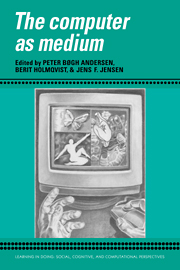Book contents
- Frontmatter
- Contents
- Series foreword
- Preface
- Contributors
- Part I Computer-based signs
- Part II The rhetoric of interactive media
- Part III Computers in context
- Introduction
- 13 Computer culture: The meaning of technology and the technology of meaning
- 14 One person, one computer: The social construction of the personal computer
- 15 Hi-tech network organizations as self-referential systems
- Comment: Disturbing communication
- 16 Dialogues in networks
- 17 Historical trends in computer and information technology
- Comment: The history of computer-based signs
- 18 A historical perspective on work practices and technology
- 19 Hypertext: From modem Utopia to post-modem dystopia?
- Index
19 - Hypertext: From modem Utopia to post-modem dystopia?
Published online by Cambridge University Press: 05 October 2010
- Frontmatter
- Contents
- Series foreword
- Preface
- Contributors
- Part I Computer-based signs
- Part II The rhetoric of interactive media
- Part III Computers in context
- Introduction
- 13 Computer culture: The meaning of technology and the technology of meaning
- 14 One person, one computer: The social construction of the personal computer
- 15 Hi-tech network organizations as self-referential systems
- Comment: Disturbing communication
- 16 Dialogues in networks
- 17 Historical trends in computer and information technology
- Comment: The history of computer-based signs
- 18 A historical perspective on work practices and technology
- 19 Hypertext: From modem Utopia to post-modem dystopia?
- Index
Summary
When Vannevar Bush, in his 1945 article As We May Think, presented his vision of the Memex, the proposed information retrieval system that later served as an inspiration for Ted Nelson's Hypertext concept, this vision was clearly and necessarily rooted in modernity as it appeared, unchallenged, at the end of World Warn.
Bush held the view that science, having been in the service of destructive forces for the duration of the war, now was able to return to its main objective - to secure progress of mankind. It was to this end that he proposed the Memex system:
Presumably man's spirit should be elevated if he can better review his shady past and analyse more completely and objectively his present problems. He has built a civilization so complex that he needs to mechanise his records more fully if he is to push his experiment to its logical conclusion and not merely become bogged down part way there by overtaxing his limited memory (Bush 1945: 108).
This utopian modern optimism elicited by Bush, was considerably tempered by the time Ted Nelson's Computer Lib appeared in 1974, a book that clearly places Nelson within the social critical tradition of the American intellectual left in the 1960s. His critical stance was augmented by the ecological awareness of the 1970s expressed through journals like Co-Evolution Quarterly and The Whole Earth Catalogue, and it is no coincidence that the editor of these two publications, Stewart Brand, wrote the introduction to the 1987 edition of Computer Lib.
- Type
- Chapter
- Information
- The Computer as Medium , pp. 477 - 490Publisher: Cambridge University PressPrint publication year: 1994



